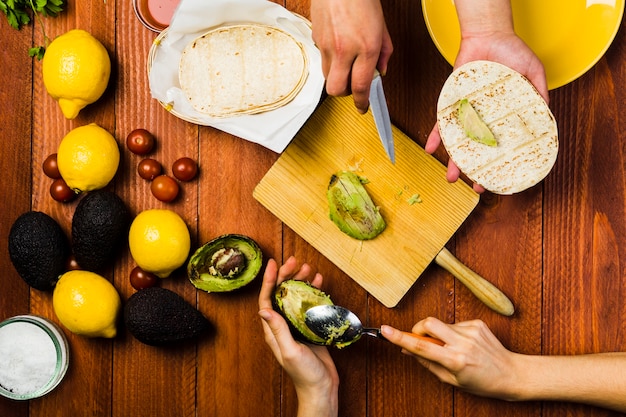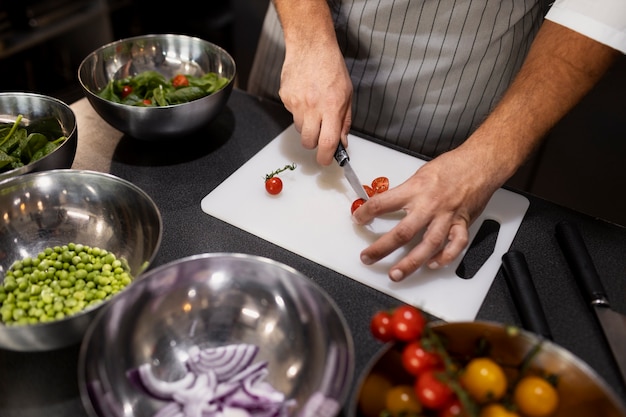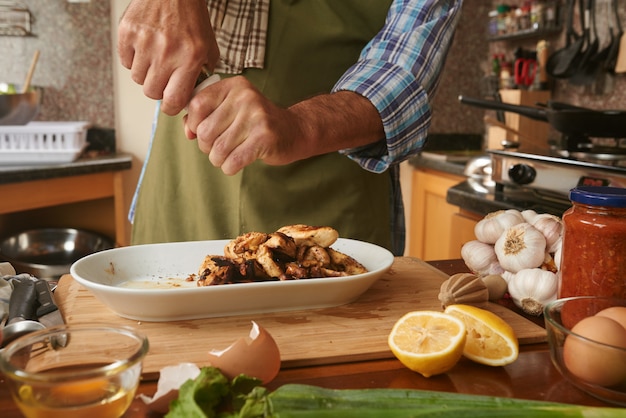ahi tuna. Just the name conjures images of sleek, crimson-hued fish, glistening with a promise of exquisite flavour. It's a true delicacy, a culinary treasure that demands respect and careful handling. I've spent years learning the ins and outs of cooking with ahi tuna, and I'm excited to share my tips and tricks with you. From the basics to more adventurous techniques, we'll explore how to unlock the full potential of this remarkable fish. Grab a pen, because we're about to embark on a delicious journey together.
Part 1: Getting to Know Ahi Tuna: The Star of the Show

Before diving into the kitchen, let's talk about the star of our show: ahi tuna. Also known as yellowfin tuna, it's a prized catch for its deep, vibrant red colour and rich, meaty flavour. Ahi tuna is a versatile ingredient, adaptable to various cooking styles – from searing and grilling to baking and even enjoying raw in sushi or tartare. The possibilities are as endless as your imagination!
Understanding Ahi Tuna: A Look Beyond the Surface
Choosing the right ahi tuna is crucial. It should have a deep crimson hue and feel firm to the touch. A pale colour or mushy texture is a sign that the fish may not be fresh or properly handled. Look for a bit of marbling in the fat, a surefire indicator of a high-quality cut that will melt in your mouth.
choosing the right cut: A Matter of Matching Flavors
Each cut of ahi tuna brings its own unique character to the table. Here's a quick guide to help you choose the right cut for your recipe:
- For searing or grilling, go for a steak cut – thick and meaty, it's perfect for creating a stunning, crispy crust.
- For sushi, sashimi, or tartare, opt for a leaner cut like the loin. It's delicate and melts in your mouth, ideal for showcasing the raw beauty of the fish.
- If you're looking for a more affordable option, consider a block or a fillet. These are versatile and suitable for grilling or baking, and you can easily slice them to your desired thickness.
I've learned the hard way that using the wrong cut can dramatically impact the outcome of your dish. Remember, the key is to match the cut to your recipe. You wouldn't try to build a house with the wrong tools, and you shouldn't approach ahi tuna preparation the same way.
Part 2: Preparing Your Tuna: Respecting the Ingredient

You've got your ahi tuna, it's time to get cooking! But first, we need to show the fish some respect by ensuring it's prepped properly. These simple steps will make a huge difference in the final result.
The Art of Patting: A Gentle Touch
The first step is to pat the tuna dry. This might seem trivial, but it's essential for achieving that beautiful, crispy sear. Excess moisture can prevent the tuna from browning properly, leading to a dull, unappetizing crust. Use paper towels and gently but firmly pat the surface of the tuna until it's dry to the touch.
Salt and Pepper: The Duo That Enhances
Next, we season our tuna. Don't underestimate the power of simple seasoning! A good sprinkle of salt and pepper will bring out the natural flavours of the fish, adding a layer of depth and richness. I prefer kosher salt for its larger crystals and freshly ground black pepper for its vibrant aroma.
You can season your tuna right before cooking or even let it sit for a few minutes to let the salt draw out some moisture, creating a more concentrated flavour. Feel free to experiment with other spices, such as garlic powder, chili flakes, or a pinch of paprika. But remember, the goal is to enhance the natural flavour of the tuna, not overwhelm it.
Part 3: Cooking Your Ahi Tuna: A Palette of Techniques

Now, the fun begins! We've got our prepped ahi tuna; let's explore some of the most popular and delicious ways to cook it. Each method brings a unique flavour and texture, so choose the one that speaks to your culinary desires.
The Searing Method: A Quick, Yet Powerful Approach
This is my go-to method for ahi tuna. It's quick, easy, and delivers a beautiful, crispy crust that contrasts perfectly with the soft, juicy centre. You need a hot pan and a bit of oil – a cast iron pan is ideal for this. Heat the pan until it's smoking hot, then add a drizzle of oil. Carefully place your tuna in the pan and let it cook for about 30 seconds per side, creating a gorgeous golden brown crust.
The key is not to overcook it! Aim for a beautiful pink centre. Using a meat thermometer is always a good idea – the ideal internal temperature for ahi tuna is between 120°F (49°C) and 130°F (54°C). Once cooked, remove the tuna from the pan and let it rest for a few minutes before slicing. Serve it with a simple salad, some rice, or your favourite sauce.
Grilling for Summer Flavors: Bringing the Outdoors In
There's nothing quite like grilling ahi tuna on a warm summer evening. The smoky aroma, the char marks, the vibrant flavours – it's a perfect combination. I recommend a gas grill, as it's easier to control the temperature. But if you're a charcoal grill enthusiast, make sure the coals are hot and ready.
You'll need medium-high heat for grilling. Oil the grill grates to prevent sticking and place the tuna on the grill. Cook for about 3-4 minutes per side, depending on the thickness, aiming for a beautiful grill mark on each side. Remember, watch the temperature closely. The centre should be pink and cooked to about 130°F (54°C). Remove the tuna, let it rest, slice, and serve it with your favourite grilled vegetables, rice, or tangy sauce.
Baking for a Gentle Touch: A Slower, Yet Delicate Approach
If you prefer a more gentle approach, baking is an excellent option for ahi tuna. It's perfect for those who want to avoid overcooking and ensure a delicate, moist texture. Preheat your oven to 350°F (175°C) and line a baking sheet with parchment paper. Place your tuna on the baking sheet and bake for 10-12 minutes, depending on the thickness.
I like to add a drizzle of olive oil and a squeeze of lemon juice to the baking sheet before placing the tuna. It helps keep the fish moist and adds a beautiful citrusy flavour. The tuna is cooked when it flakes easily with a fork. Remove it from the oven, let it rest, slice, and serve with roasted vegetables, mashed potatoes, or a creamy sauce.
Part 4: Mastering the Art of Rare Tuna: Embracing the Unconventional
The idea of rare tuna might seem daunting, but it can be a truly rewarding experience. The key is to understand the nuances of texture and flavour and choose the right cut. The loin cut is a good choice, as it's lean and has a delicate texture that complements the rare cooking method.
Searing for a Perfect Finish: Quick Heat, Maximum Impact
The best way to cook rare tuna is by searing it quickly on a hot pan. This creates a beautiful brown crust while keeping the centre raw. Heat a cast iron pan until it's smoking hot, add a drizzle of oil, and sear the tuna for about 30 seconds per side.
You can also try grilling rare tuna, but be cautious. The intense heat can easily overcook the tuna, so the pan is a safer bet.
Don’t Forget the Rest: Allowing Flavors to Settle
Once the tuna is seared, take it off the pan and let it rest for a few minutes. This allows the heat to continue cooking the tuna slightly from the inside out, creating a gentle, even texture. Slice your tuna and serve it with your favourite accompaniments.
Part 5: Mastering the Art of Raw Tuna: Embracing a Cultural Tradition
The thought of eating raw tuna might make some people nervous, but it's a staple in many cultures, particularly in Japanese cuisine. The key is to use sushi-grade tuna, which has been carefully inspected and frozen to meet safety standards.
Choosing the Right Tuna: Seeking the Highest Quality
Find a reputable fishmonger who can provide you with sushi-grade tuna. This tuna has been specifically inspected and frozen to kill any parasites. It should have a deep, vibrant red colour and feel firm and springy to the touch.
Freezing for Safety: Ensuring a Safe Culinary Experience
Sushi-grade tuna is often frozen before being sold to kill any parasites. The ideal freezing temperature is -31°F (-35°C) for at least 7 days. If you buy tuna that hasn't been frozen, it's crucial to freeze it yourself for at least 24 hours.
Preparing Raw Tuna: Transforming the Ingredient
Once you have your sushi-grade tuna, prepare it by removing any skin or bones. You can slice it into thin slices for sashimi or dice it for tartare.
Serving Raw Tuna: A World of Culinary Possibilities
Raw tuna can be served in various ways. Sashimi is often served with a simple soy sauce, wasabi, and pickled ginger, allowing the tuna's flavour to shine. Tartare can be mixed with chopped onions, capers, and aioli for a more complex flavour profile. The possibilities are endless!
Part 6: Accompanying Flavors: Finding the Perfect Harmony
Your ahi tuna is beautifully cooked, looking and smelling divine. Now, it's time to think about the perfect accompaniment. It's about finding the right flavours that enhance the tuna's natural taste, creating a harmonious symphony on your plate.
The Power of Simplicity: Less is More
Don't underestimate the power of simplicity. Sometimes, the best accompaniments are the most straightforward. A drizzle of olive oil and a squeeze of lemon juice can bring out the tuna's natural flavour beautifully. A simple salad with fresh herbs and a light vinaigrette also works wonderfully.
Flavors that Sing: Adding Depth and Complexity
If you're looking for something more exciting, there are plenty of options. I love using sauces that complement the tuna's rich flavour without overpowering it. Here are a few ideas:
- A classic soy sauce and ginger sauce is a timeless favourite, bringing a touch of Asian flair to the dish.
- For a bit of heat, try a chili-lime sauce, adding a zingy kick to the taste buds.
- For a tangy twist, go for a ponzu sauce, a citrusy and umami-rich condiment that will elevate your tuna to new heights.
Creating a Culinary Symphony: Matching Textures and Colours
Think about textures and colours too. A crunchy salad or some roasted vegetables can provide a nice contrast to the soft texture of the tuna. And don't forget about colour! A vibrant green salad or some bright red tomatoes can add a splash of colour to your plate, creating a visually appealing and delicious masterpiece.
Part 7: Storage Tips: Keeping Your Tuna Fresh
You've bought the freshest ahi tuna, cooked it to perfection, and now you need to ensure it stays that way. Good storage is crucial for preserving the quality and flavour of your tuna. Here's how to make your ahi tuna last.
Refrigeration: The Short-Term Solution
If you're not using your tuna immediately, refrigerate it. Wrap it tightly in plastic wrap or foil to prevent it from drying out, or store it in an airtight container.
Freezing for a Later Date: A Long-Term Option
If you want to freeze your tuna, you can do so for up to three months. Wrap it tightly in plastic wrap or foil, then place it in a freezer-safe bag or container.
Thawing with Care: Releasing the Tuna From Its Frozen State
When you're ready to use your frozen tuna, thaw it in the refrigerator overnight. Never thaw it at room temperature, as this can encourage bacterial growth and compromise its quality.
Part 8: FAQs: Addressing Your Questions
I know you might have a few questions about ahi tuna, so let's address them.
1. What does ahi tuna taste like?
Ahi tuna has a rich, meaty flavour with a hint of sweetness. It's a bit more robust than other types of tuna, with a lovely firm texture that melts in your mouth.
2. Is ahi tuna good for you?
Absolutely! Ahi tuna is a good source of protein, omega-3 fatty acids, and other essential nutrients. It's a healthy and delicious addition to any diet.
3. How do I know if ahi tuna is fresh?
Look for a piece with a deep red colour and firm texture. It should also smell fresh and slightly briny. Avoid any tuna that looks pale or feels mushy.
4. Can I cook ahi tuna in the microwave?
It's not recommended. Microwaving tuna can lead to uneven cooking and a dry, tough texture. Stick to the methods I mentioned earlier for the best results.
5. How long can I keep ahi tuna in the refrigerator?
You can keep fresh ahi tuna in the refrigerator for 1-2 days. But remember, the longer you keep it, the less fresh it will be. So, use it as soon as possible for the best flavor and texture.
Part 9: Conclusion: Embracing the culinary journey
There you have it, my friend. Ahi tuna, from raw to delicious. It's a culinary adventure, and it's worth taking. Don't be afraid to experiment and find what works best for you. Remember, cooking is all about enjoying the process. So, go forth, cook some delicious ahi tuna, and have fun!
Everyone is watching

Perfect Rice Every Time: The Ultimate Guide to Cooking Rice
Cooking TipsAs a self-proclaimed foodie, I've always been a bit obsessed with rice. It's the foundation of countless cuisi...

Prime Rib Roast Cooking Time Chart: Per Pound Guide
Cooking TipsPrime rib roast. Just the name conjures images of lavish dinners, crackling fires, and hearty laughter. It’s ...

The Ultimate Guide to Cooking Asparagus: Tips, Techniques, and Recipes
Cooking TipsAsparagus. The mere mention of this spring delicacy conjures up images of vibrant green spears, crisp and burs...

Ultimate Guide to Cooking the Perfect Thanksgiving Turkey
Cooking TipsThanksgiving. Just the word conjures up images of overflowing tables laden with delicious food, the scent of r...

How Long to Bake Potatoes in the Oven (Perfect Every Time)
Cooking TipsBaked potatoes are a staple in my kitchen. They're incredibly versatile, delicious, and surprisingly easy to m...
